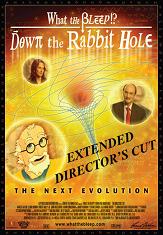 Mindboggling, jaw-dropping, thrilling, engrossing. All these adjectives apply–and then some–when describing “What the Bleep!? Down the Rabbit Hole: Extended Director’s Cut,” playing in select cities now. (It’s basically a long version of last year’s very popular “What the Bleep Do We Know!?“–already available on DVD.)
Mindboggling, jaw-dropping, thrilling, engrossing. All these adjectives apply–and then some–when describing “What the Bleep!? Down the Rabbit Hole: Extended Director’s Cut,” playing in select cities now. (It’s basically a long version of last year’s very popular “What the Bleep Do We Know!?“–already available on DVD.)
“Is the spirit and science tying the knot once more?” an announcer asks at the beginning of the film, following a hilariously irreverent and brief history of religion’s bumpy relationship with science (complete with bumper car illustrations). If “What the Bleep!?” has anything to say about the current and future state of science and spirituality, it’s that tying the knot between them again is an inevitability driven by the extraordinary knowledge that quantum physicists and mathematicians are uncovering today. This knowledge may eventually require a “quantum conversion” or a “quantum horizon shift” (to use the language of scholars describing spiritual awakenings) among all of us when it comes to how we perceive reality, and therefore religion and spirituality.
Mostly documentary, with a tiny bit of story featuring Marlee Matlin as Amanda (who experiences a kind of “quantum horizon shift” over the course of the movie), the scientists, mathematicians, and scholars interviewed collectively deconstruct the classical, “mechanical” understanding of the human body, the world, and how everything operates in relation to everything else (as individuals, as separate objects). They then build on the notion that all the universe, consciousness itself, is a great collective organism in which we all swim, move, live. This notion takes the statement “what I think effects the world” to a new level, since, as one scientist explains, the universe–and we, the human elements of it–are made of an “ocean of pure potentiality, abstract potentiality, pure abstract self-aware consciousness that gives rise to everything.”
In other words, as conscious elements of the larger universe, we are its co-creators. For lack of a better term, as conscious beings we are each of us gods (but not the only gods, as all consciousness is god), creating reality with our thoughts, actions, choices, and by merely being here and watching and paying attention.
One of the most mindboggling things in the movie’s commentary is the fact that elementary particles act differently when they are observed than when they are not. You need to go see the film yourself to get more on that one. It’s one of the most fascinating ideas of all, but I’d need a quantum physicist here with me right now to explain it for you.
What does this mean on a spiritual level (other than the fact that we are all co-creators of existence–that “God is not within, but in fact we ourselves are divine”)? Those interviewed cite the idea of separateness as the single biggest problem across humanity, because quantum physics “has its own spirituality of unity” in this area: It tells us that separateness does not exist, that we are all literally connected. One scientist wonders: “When do we make the shift from me to one?” Since life is effected by observation (again, literally), another scientist talks about the importance of “practicing the skill of observation” within the world, with regard to our own bodies and health, that of the people we care about and those we’ve never met, because attention and intention changes the world. The potential impact this idea has on “the power of prayer” could be extraordinary, and the notion that prayer can “work” and that prayer “helps” patients who are sick, for example, begin to make sense at a new level.
Totally mindboggling stuff.
If it’s playing at a theater near you–GO! I am planning on going again and buying the DVD when it comes out, since I think it would add some much-needed spice to my Intro to Religious Studies class at some point during the semester (perhaps when discussing the Scientific Revolution and its impact on religious thinking?), especially that funny quick bit at the beginning about rocky relationship of science and religion across the ages.


